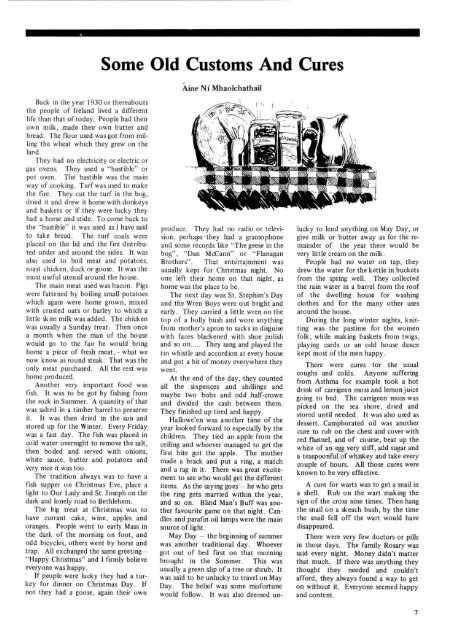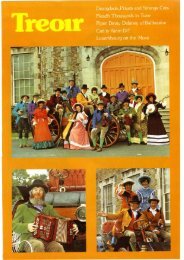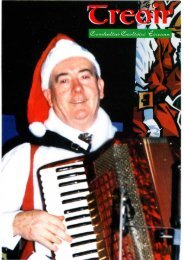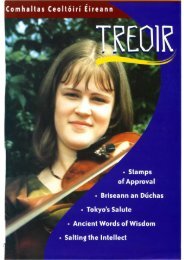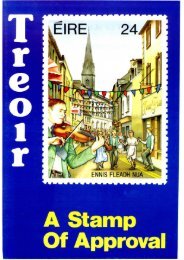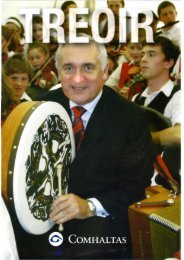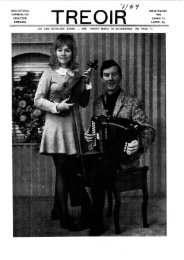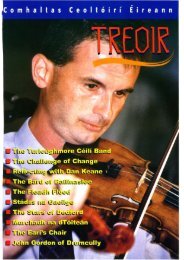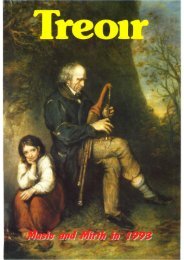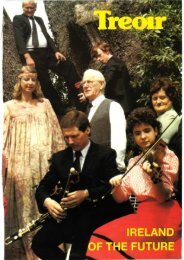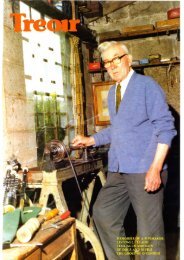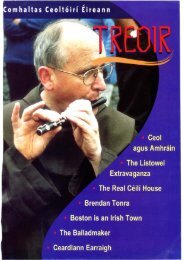You also want an ePaper? Increase the reach of your titles
YUMPU automatically turns print PDFs into web optimized ePapers that Google loves.
Back in the year 1930 or thereabouts<br />
the people of Ireland lived a different<br />
life than that of today. People had their<br />
own milk , made their own butter and<br />
bread. The flour used was got from milling<br />
the wheat which they grew on the<br />
land .<br />
They had no electricity or electric or<br />
gas ovens. They used a " bastible" or<br />
pot oven. The bastible was the main<br />
way of cooking. Turf was used to make<br />
the fire . They cut the turf in the bog,<br />
dried it and drew it home with donkeys<br />
and baskets or if they were lucky they<br />
had a horse and stide. To come back to<br />
the "bastible" it was used as I have said<br />
to take bread . The turf coals were<br />
placed on the lid and the fire distributed<br />
under and around the sides. It was<br />
also used to boil meat and potatoes,<br />
roast chicken , duck or goose. It was the<br />
most useful utensil around the house.<br />
The main meat used was bacon. Pigs<br />
were fattened by boiling small potatoes<br />
which again were home grown, mixed<br />
with crusted oats or barley to which a<br />
little sk im milk was added. The chicken<br />
was usually a Sunday treat. Then once<br />
a month when the man of the house<br />
would go to the fair he would bring<br />
home a piece of fresh meat, - what we<br />
now know as round steak. That was the<br />
only meat purchased. All the rest was<br />
home produced.<br />
Another very important food was<br />
fish. It was to be got by fishing from<br />
the rock in Summer. A quantity of that<br />
was salted in a timber barrel to preserve<br />
it. It was then dried in the sun and<br />
stored up for the Winter. Every Friday<br />
was a fast day . The fish was placed in<br />
co ld water overnight to remove the salt,<br />
then boiled and served with onions,<br />
white sauce , butter and potatoes and<br />
very nice it was too.<br />
The tradition always was to have a<br />
fish supper on Christmas Eve , place a<br />
light to Our Lady and St. J oseph on the<br />
dark and lonely road to Bethlehem.<br />
The big treat at Christmas was to<br />
have currant cake, wine, apples and<br />
oranges. People went to early Mass in<br />
the dark of the morning on foot , and<br />
odd bicycles, others went by horse and<br />
trap. All exchanged the same greeting<br />
"Happy Christmas" and I firmly believe<br />
everyone was happy.<br />
If people were lucky they had a turkey<br />
for dinner on Christmas Day. If<br />
not they had a goose, again their own<br />
Some Old Customs And Cures<br />
Aine Ni Mhaolchathail<br />
produce. They had no radio o r television<br />
, perhaps · they h·ad a gramophone<br />
and some records like "The geese in the<br />
bog", " Dan MCCann" or " Flanagan<br />
Brothers". That enterta.inment was<br />
usually kept for Christmas night. No<br />
one left their home on that night, as<br />
home was the place to be.<br />
The next day was St. Stephen's Day<br />
and the Wren Boys were out bright and<br />
early . They carried a little wren on the<br />
top of a holly bush and wore anything<br />
from mother's apron to sacks in disguise<br />
with faces blackened with shoe polish<br />
and so on..... They sang and played the<br />
tin whistle and accordion at every house<br />
and got a bit of money everywhere they<br />
went.<br />
A t the end of the day, they counted<br />
all the sixpences and shillings and<br />
maybe two bobs and odd half-crown<br />
and divided the cash between them.<br />
They finished up tired and happy.<br />
Hallowe'en was another time of the<br />
year looked forward to especially by the<br />
children. They tied an apple from the<br />
ceiling and whoever managed to get the<br />
first bite got the apple. The mother<br />
made a brack and put a ring, a match<br />
and a rag in it. There was great excitement<br />
to see who would get the different<br />
items. As the saying goes - he who gets<br />
the ring gets married within the year,<br />
and so on. Blind Man's Buff was another<br />
favourite game on that night. CandIes<br />
and parafin oil lamps were the main<br />
source of light.<br />
May Day - the beginning of summer<br />
was another traditional day. Whoever<br />
got out of bed first on that morning<br />
brought in the Summer. This was<br />
usually a green slip of a tree or shrub. It<br />
was said to be unlucky to travel on May<br />
Day. The belief was some misfortune<br />
would follow. It was also deemed un-<br />
lucky to lend anything on May Day, or<br />
give milk or butter away as for the remainder<br />
of the year there would be<br />
very little cream on the milk.<br />
People had no water on tap, they<br />
drew the water for the kettle in buckets<br />
from the spring well. They collected<br />
the rain water in a barrel from the roof<br />
of the dwelling house for washing<br />
clothes and for the many other uses<br />
around the house.<br />
During the long winter nights, knitting<br />
was the pastime for the women<br />
folk, while making baskets from twigs,<br />
playing cards or an odd house dance<br />
kept most of the men happy.<br />
There were cures for the usual<br />
coughs and colds. Anyone suffering<br />
from Asthma for example took a hot<br />
drink of carrigeen moss and lemon juice<br />
going to bed. The carrigeen moss was<br />
picked on the sea shore, dried and<br />
stored until needed. It was also used as<br />
dessert. Camphorated oil was another<br />
cure to rub on the chest and cover with<br />
red flannel, and of course, beat up the<br />
white of an egg very stiff, add sugar and<br />
a teaspoonful of whiskey and take every<br />
couple of hours. All those cures were<br />
known to be very effective.<br />
A cure for warts was to get a snail in<br />
a shell. Rub on the wart making the<br />
sign of the cross nine times. Then hang<br />
the snail on a skeach bush, by the time<br />
the snail fell off the wart would have<br />
disappeared .<br />
There were very few doctors or pills<br />
in those days. The family Rosary was<br />
said every night. Money didn't matter<br />
that much. If there was anything they<br />
thought they needed and couldn't<br />
afford, they always found a way to get<br />
on without it. Everyone seemed happy<br />
and content.<br />
7


